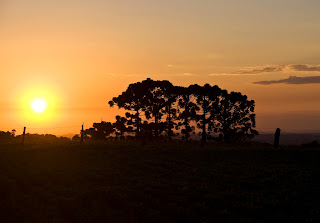 |
| Chilly start to the day in Pato Branco |
Ask most people around the world what they think of the
Brazilian climate and they will tell you that it’s warm, hot, tropical or any
other similar adjective. Mention winter
and they’ll say it can’t be that bad.
Well…
Brazil is a large country from Northern parts above the
equator and the South extending below the tropic of Capricorn. So yes, Brazil is definitely a tropical
country and there are parts of the country where a slight dip in temperature is
barely noticed, parts where there is no real change and parts where the seasons
are defined as rainy and dry.
 |
| One of the many winter memes from Paraná |
This is my first experience of a Brazilian winter, or a
Paraná winter to be specific, and so far, it doesn’t feel very tropical! While I had been told about how cold it can
get and seen countless memes showing blue, frozen people wrapped in blankets
with icicles hanging from their face, nothing quite prepares you for the
experience.
After the heat of summer, I was expecting a gradual
cool-down to a couple of months of winter, followed by a warm-up back towards
summer. What actually happened was the
start of a gradual cool-down, then a heat wave in April and then a sudden
plummet into winter at the end of the month.
If came as a bit of a shock, one night, struggling to sleep in
oppressive heat and humidity, next night, extra blankets and huddling close for
warmth. The weather stayed mild for some
time – a bit chilly at night, warmish during the day – not too bad…
 |
| The mercury dips and these photos appear. Not so bad? It is when it's colder inside the house! |
Then came June.
During the night, the mercury dips perilously close to 0°C, raising
above 10°C during the day. This doesn’t
sound too bad, and I used to laugh at the complaints I heard, but then you come
back to the fact that Brazil is a tropical country. For most of the year, the weather is either
warm, hot or very hot, and the houses have been built to accommodate this and
allow the heat to escape. This means
that when the temperature drops outside, indoor temperatures are following
close behind. Central heating on a timer
set to start half an hour before breakfast time is a distant (blissful) memory,
getting undressed for a shower is torturous and the thought of leaving the hot
water and returning to the chilly air fills you with dread. While we have heaters, they are mostly fan
heaters sending directional blasts of warm air, with the unfortunate side
effect that areas not covered appear to suffer a breeze of even colder air,
sending people into hiding beneath layers of blankets, wearing thick jumpers,
jackets and hats.
This all makes me yearn for Britain and the promise of a
nice warm house – until I think about summer and how the efficiently insulated
houses turn on their inhabitants, transforming into hot, sticky saunas and then
I think of how much more tolerable hot summer days can be here, relaxing at the
beach, going to the river, barbecues, caipirinhas and beer…
But June isn’t over, July is coming and I can’t find my
gloves…



